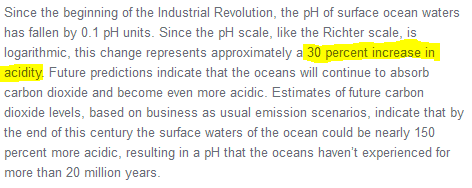Old Rocks
Diamond Member
http://www.blog.thesietch.org/2012/04/12/ocean-acidification-killing-farmed-oysters/
Marine researchers have definitively linked the collapse of oyster seed production at a commercial oyster hatchery in Oregon to an increase in ocean acidification.
Larval growth at the hatchery declined to a level considered by the owners to be non-economically viable.
A study by the scientists found that increased seawater carbon dioxide (CO2) levels, resulting in more corrosive ocean water, inhibited the larval oysters from developing their shells and growing at a pace that would make commercial production cost-effective.
As atmospheric CO2 levels continue to rise, this may serve as the proverbial canary in the coal mine for other ocean acidification impacts on shellfish.
Results of the research are published this week in the journal Limnology and Oceanography, published by the Association for the Sciences of Limnology and Oceanography (ASLO).
The research was funded by a grant from the National Science Foundation (NSF)s Science, Engineering and Education for Sustainability (SEES) Ocean Acidification solicitation.
Studies funded by NSFs SEES Ocean Acidification solicitation are well-positioned to determine the specific mechanisms responsible for larval mortality in Pacific Northwest oyster hatcheries, said David Garrison, program director in NSFs Division of Ocean Sciences.
This is one of the first times that we have been able to show how ocean acidification affects oyster larval development at a critical life stage, said Burke Hales, an Oregon State University (OSU) chemical oceanographer and co-author of the paper.
Marine researchers have definitively linked the collapse of oyster seed production at a commercial oyster hatchery in Oregon to an increase in ocean acidification.
Larval growth at the hatchery declined to a level considered by the owners to be non-economically viable.
A study by the scientists found that increased seawater carbon dioxide (CO2) levels, resulting in more corrosive ocean water, inhibited the larval oysters from developing their shells and growing at a pace that would make commercial production cost-effective.
As atmospheric CO2 levels continue to rise, this may serve as the proverbial canary in the coal mine for other ocean acidification impacts on shellfish.
Results of the research are published this week in the journal Limnology and Oceanography, published by the Association for the Sciences of Limnology and Oceanography (ASLO).
The research was funded by a grant from the National Science Foundation (NSF)s Science, Engineering and Education for Sustainability (SEES) Ocean Acidification solicitation.
Studies funded by NSFs SEES Ocean Acidification solicitation are well-positioned to determine the specific mechanisms responsible for larval mortality in Pacific Northwest oyster hatcheries, said David Garrison, program director in NSFs Division of Ocean Sciences.
This is one of the first times that we have been able to show how ocean acidification affects oyster larval development at a critical life stage, said Burke Hales, an Oregon State University (OSU) chemical oceanographer and co-author of the paper.


